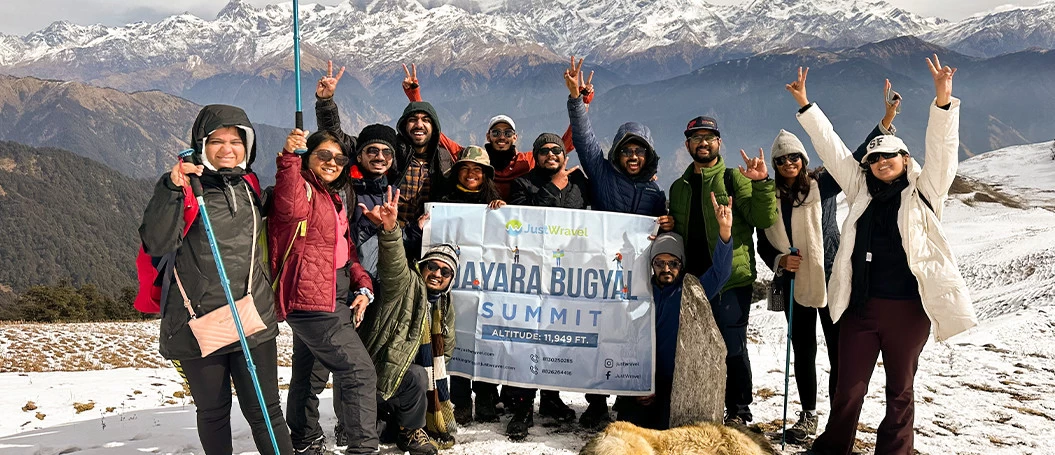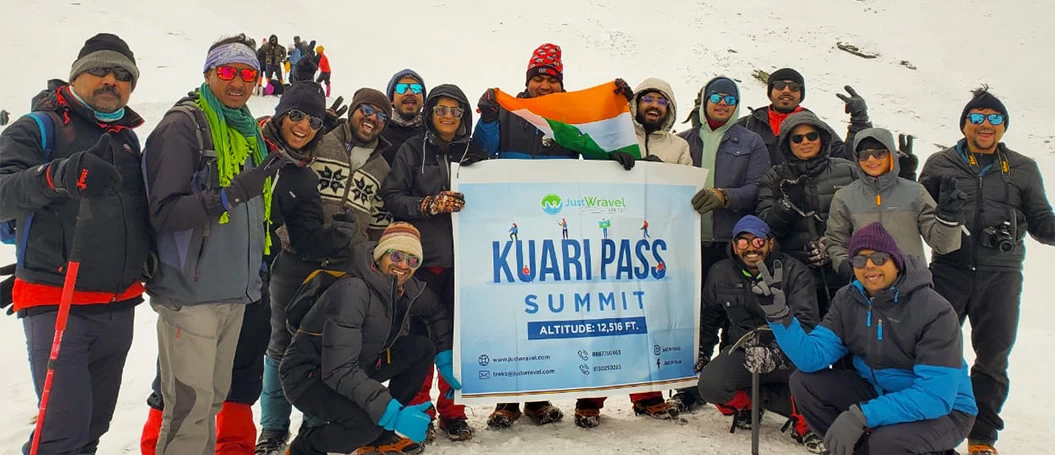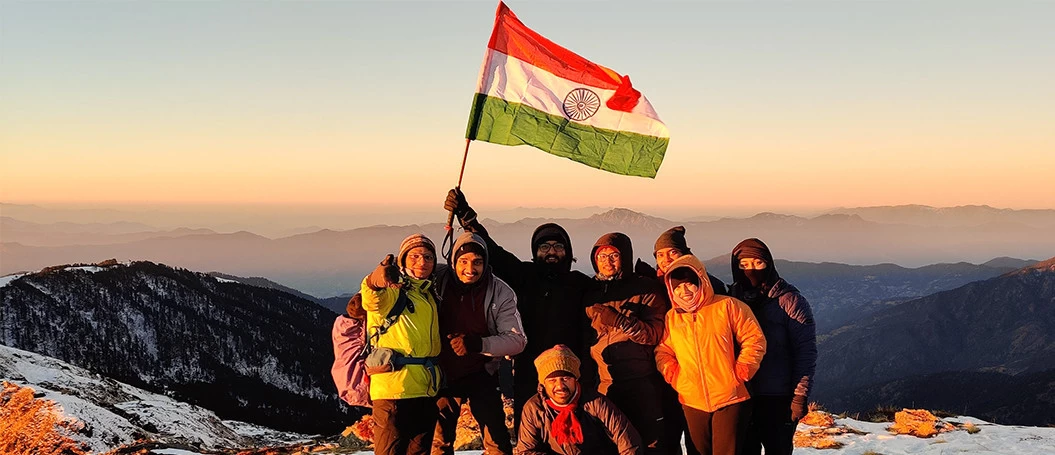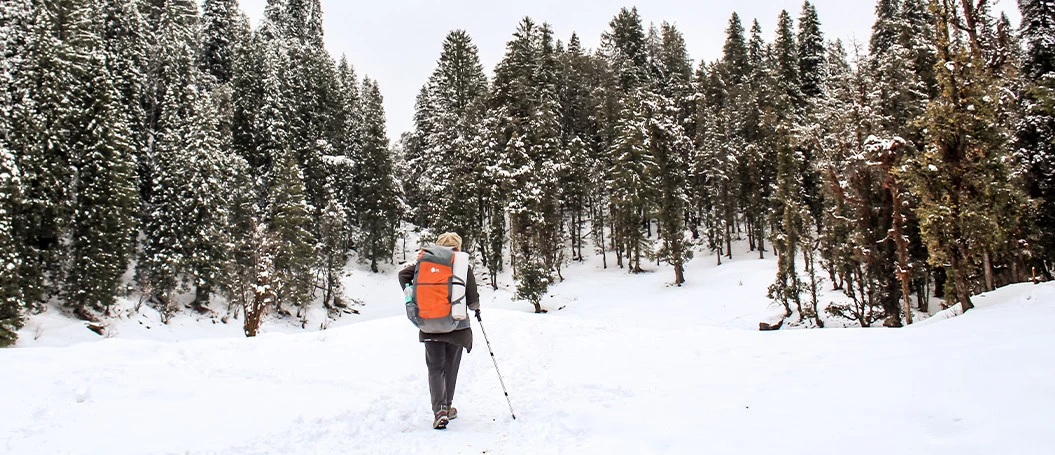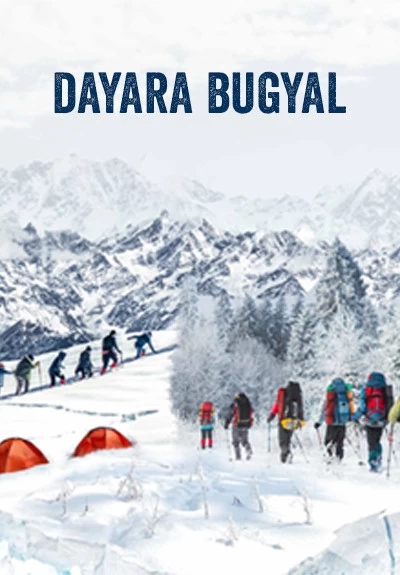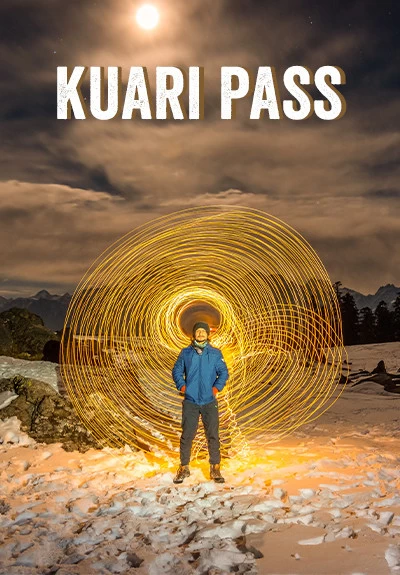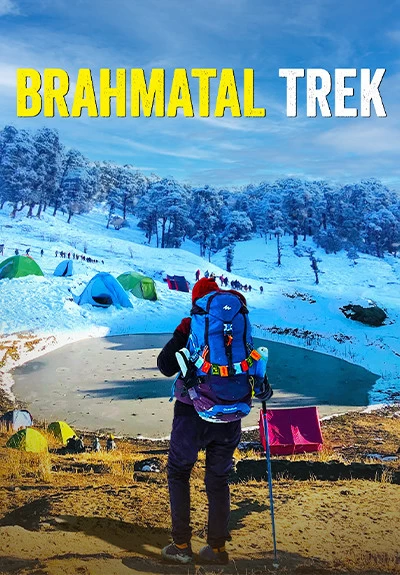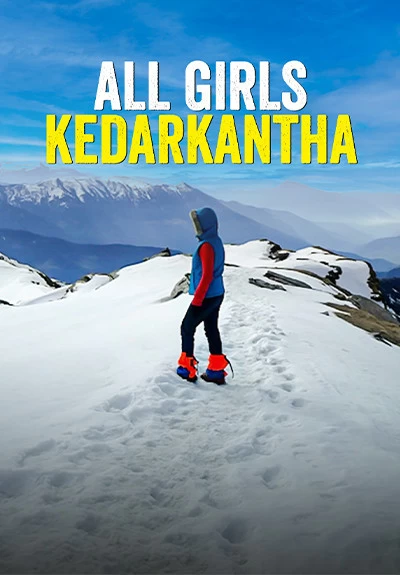
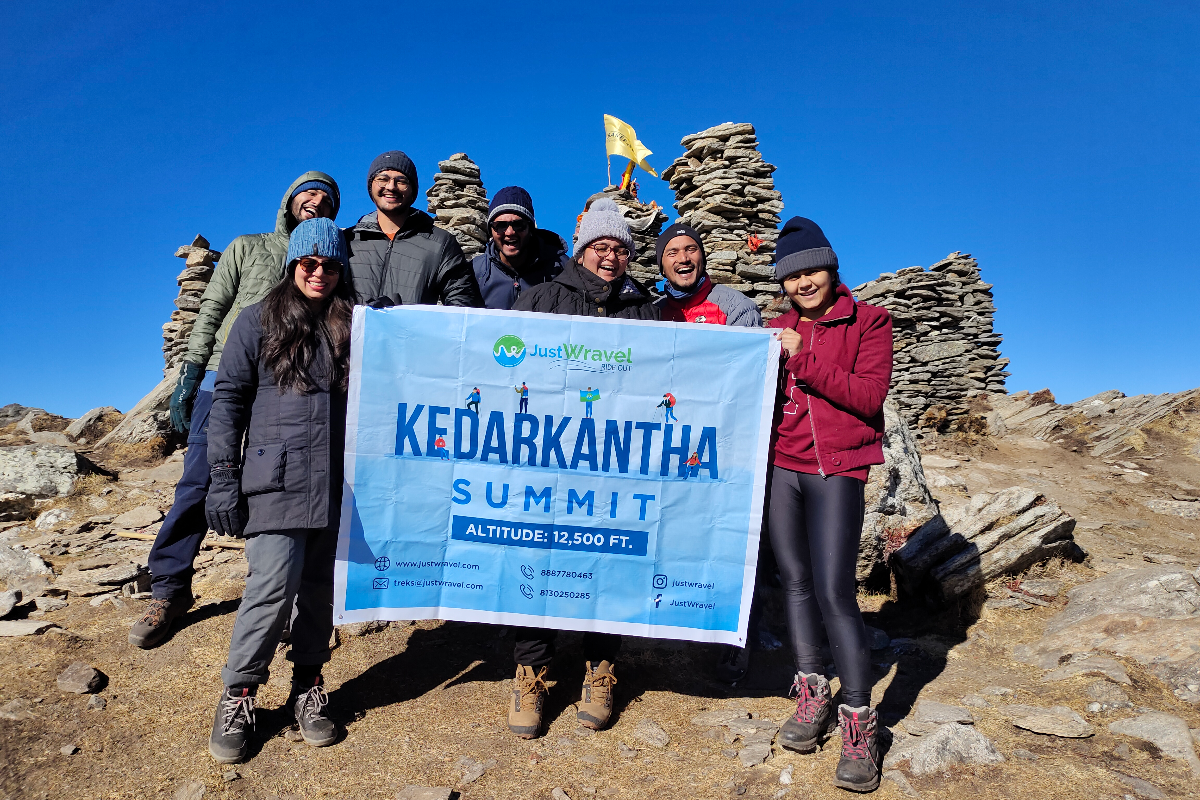
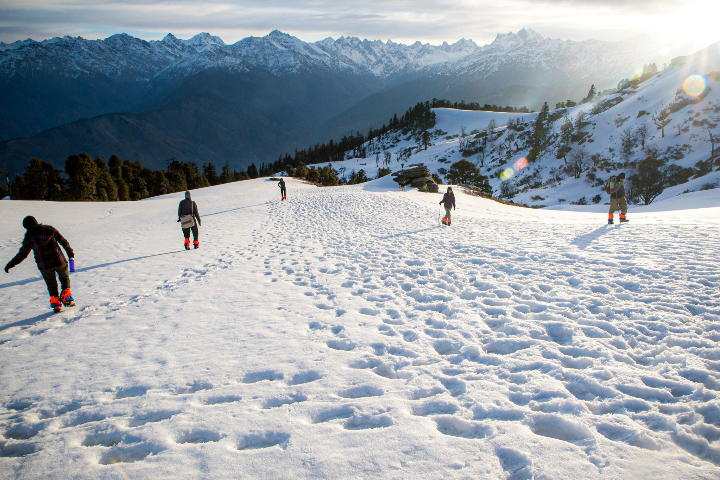
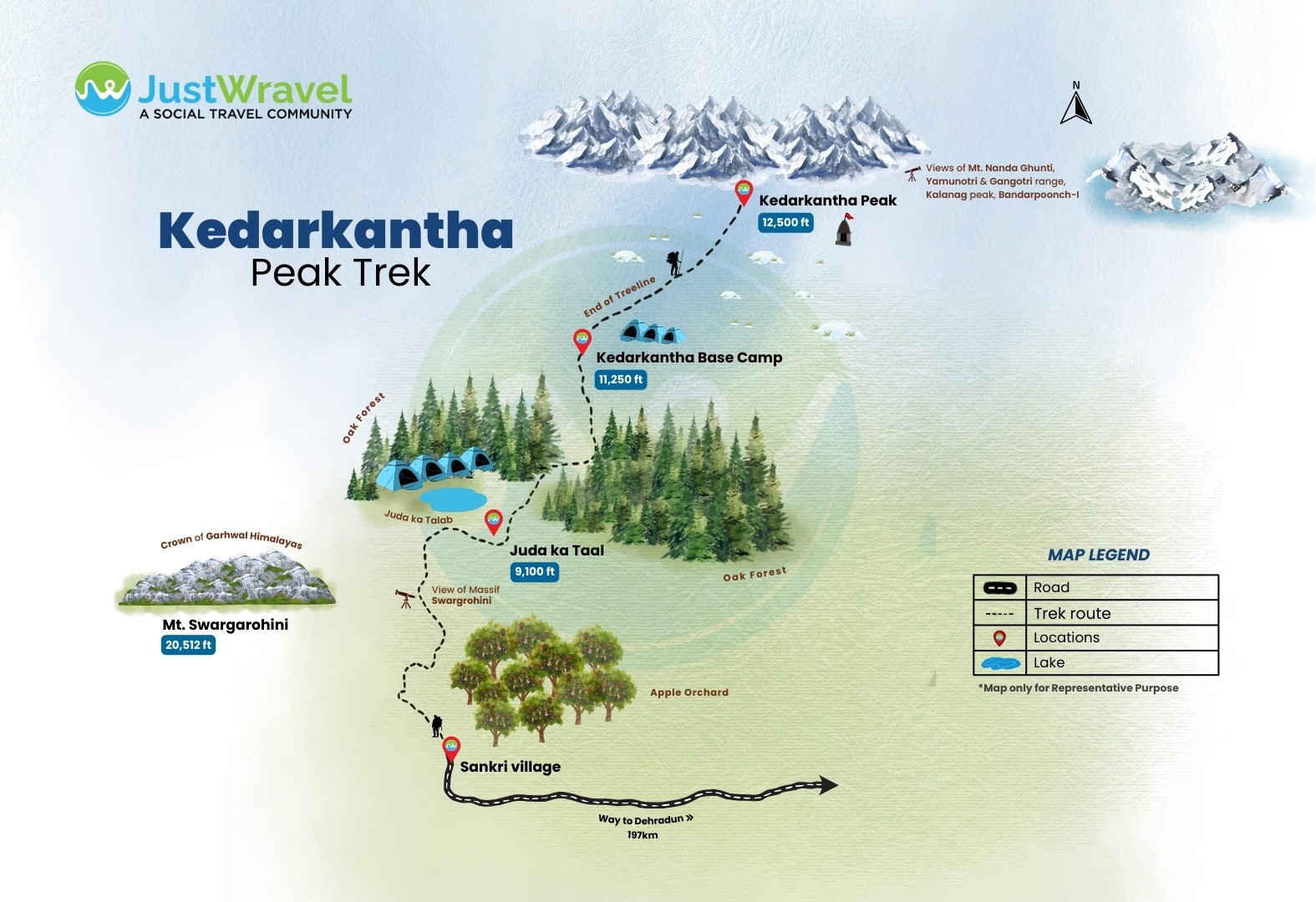
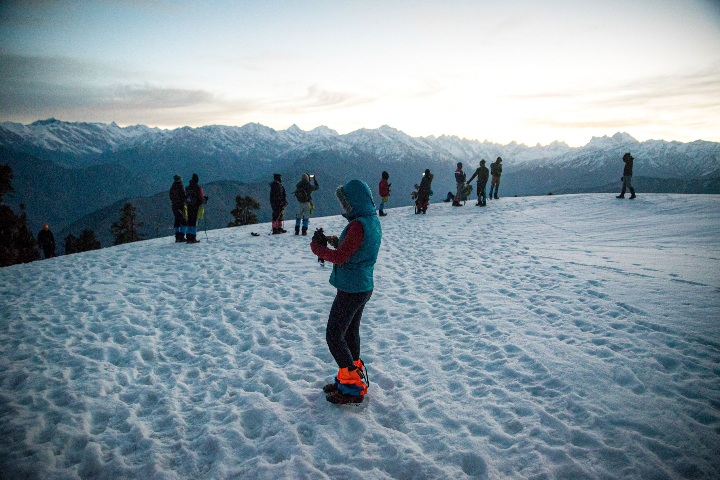
Kedarkantha Trek
Details
Inclusions
Safe Travel
Flexible Cancellation
Easy EMI
Certified Captains
24/7 Support
Overview
The Queen of Winter Treks, Kedarkantha Trek is undoubtedly the first choice that comes to mind when you think of winter trekking. Kedarkantha is sometimes known as "Kedar Khand," which is a name of historical significance in the area that roughly means "Section of Lord Shiva." Nevertheless, Kedarkantha means "Throat of Lord Shiva." As per the legend, Lord Shiva used to meditate in Kedarkantha before moving to Kedarnath.
Elevated at 12,500 ft, Kedarkantha is one of the breathtaking peaks of the whole majestic Himalayan range. Out of all the best winter treks in India, Kedarkantha Trek is the most popular choice attracting thousands of hikers and trekkers across the country. It is suitable for everyone from novice trekkers to those who are experts.
This 4-night, 5-day Kedarkantha trek is organized to cater to those who prefer to be in calm nature with unpredictable paths and mysterious valleys with a love for adventure. Famous for its awe-inspiring sight of snow-covered mountains, the summit gives a fleeting look at several ranges, namely Black Peak, Swargarohini, Gangotri, and Yamunotri. The summit's name means Lord Shiva's Throat and its association with Lord Shiva, and the stories and folklores that come from the locals add to its beauty and mix the experience.
JustWravel’s Kedarkantha Trek will kick off at Dehradun then we will navigate through a tiny village Sankri which is the base camp for this long trek of 20 kilometers. We will spend a night at our designated homestay or hotel, introducing ourselves and sharing experiences, before going to bed for the night. The next day, after a briefing session from our trek leader, we will go to our first checkpoint, Juda Ka Taal, where we will spend the day at the campsite, enjoying lunch and dinner while looking at the Swargarohini ridges.
The following day, we will carry on our trek to the Kedarkantha base camp positioned at 11,200 ft above sea level. After a hot lunch and doing some random activities such as snowball fights, we will start our overnight stay at the base camp itself.
After enduring the highs and lows of this short trek and watching the magical sunsets, we will make our final trek to the Kedarkantha summit before dawn. One of the most memorable moments of this trek is the early sunrise at the top which will make you forget about your weariness and put you in complete tranquility. One thing that sets the Kedarkantha trek apart is that it is classified as a moderately difficult trek. It is beginner-friendly and gives trekkers a chance to enjoy the splendid 360-degree view of the majestic Himalayan ranges thus, making the experience of trekking all the more enjoyable. The coldest place along the trekking route is Juda Ka Taal where during the winter months the lake is frozen completely. The sun glimmers on its surface like diamonds causing it to have a golden coloration. The trek gets more interesting as you proceed, with enchanting landscapes along the way. If the weather gods are kind, you may find yourself amidst the snowfall. A large number of people who go to Kedarkantha Trek continue coming back, not only for the summit but also for the culture and cuisine. Apart from the peaked rice variety which is one of the specialties of the Kedarkantha region, you have to try the well-cooked red rice as it assists the body stay warm during winters.
The carrying of electronic devices that work only with a network connection is not advisable. The network is lost just before arriving at Sankri Village, the starting point of the trek. Although the Kedarkantha trek is accessible year-round, most people prefer to visit during winter to witness the pristine snow, particularly in December and January. The best time to visit Kedarkantha is from November to February. It is one of those places where the full essence of the experience cannot be captured on the first visit, so trekkers often return. In conclusion, based on popular opinion and its widespread appeal, the Kedarkantha trek can be easily categorized as ‘The Best Winter Trek in India’. If you’re overwhelmed by multiple winter trek options in India and unsure of which to choose, Kedarkantha should be an easy decision.
So, make some room for the Kedarkantha Trek in your 2024 travel bucket list, and keep your backpack ready for this winter season.
How to Reach Kedarkantha Trek
- By Air: The closest airport to the Kedarkantha Trek is Jolly Grant Airport in Dehradun, located approximately 25 kilometers away. There is a daily flight from Delhi to Dehradun. Once you reach Dehradun, you can either hire a taxi or use public transportation to reach the base camp Sankri.
- By Train: If you are coming from Delhi to Kedarkantha, you have the option to take a train to Dehradun. There are frequent trains connecting Delhi and Dehradun, so you can choose to travel overnight. Upon reaching Dehradun, you can then take a private vehicle or a bus to Sankri.
- By Road: Regular bus services are available from Delhi to Dehradun. It is recommended to take a Delhi government bus from Kashmere Gate to Dehradun. Once you arrive in Dehradun, you can either use public transportation or rent a private vehicle to reach Sankri.
Extended Read: How To Reach Kedarkantha
Best Time to Visit Kedarkantha Trek
The Kedarkantha trek is unique among the Indian Himalayas as it can be done all year round, except for July and August when it is closed due to heavy rainfall. The trek is divided into four seasons, each offering its own distinct terrain, difficulty, and weather conditions.
Winter – November to March
During November, December, January, and February, the Kedarkantha Trek is famous for its winter journey. The snow-covered landscapes and thrilling summit ascent make it a popular choice, especially for beginners. You will trek through deep snow-covered forests and set up camps in clearings amidst the snowdrifts.
Spring
In March and April, Kedarkantha still retains a significant amount of snow, particularly in the upper campgrounds near the summit. The blooming rhododendrons and newly exposed grasses create a stunning contrast against the snowy backdrop as you ascend higher. By April, most of the snow has melted, and Kedarkantha comes alive with the beautiful scenery after its winter slumber.
Summer
May and June bring the brilliant morning sun to Kedarkantha. The nights are not as cold as in other months, and there is a lower chance of rainfall. This is also the time when the trail is less crowded, as most people have moved on to higher-altitude hikes. If you prefer a more solitary experience, May and June are the perfect months to visit.
Monsoon
September, October, and November mark the post-monsoon season when the entire journey comes to life. The meadows and forests are fresh and vibrant, and the air is crisp. The upper Himalayan vistas are breathtaking during these months.
Read More: Best Time to Visit Kedarkantha Trek
Why Kedarkantha Trek is the Best Winter Trek
If you've ever pondered which Indian winter trek is the greatest, Kedarkantha's name has probably come up. If you're wondering why people go to Kedarkantha, the five main attractions are the snow, forest, frozen lake, 360-degree summit view, and camping experience. The unmatched splendor of the Kedarkantha Trek in the winter is what makes it unique.
- Winter Wonderland: Kedarkantha Trek is one of the best winter treks in the Himalayas, being beautiful with snow-covered peaks and chilly nights.
- Mind-Bending Camping Adventure: During the Kedarkantha Trek, you can camp at some really cool and unique campsites with great mountain views and a close relationship with nature.
- Frozen Forests: Trekking through the dense Himalayan coniferous forests and glacial landscapes you will learn to camp in the captivating winter scenes.
- Frozen Lake - Juda Ka Taalab: Juda Ka Taalab is a frozen lake of extraordinary beauty that you should spend time on because it will be a peaceful place to meditate and take photos.
- Beginner-Friendly Trek: Kedarkantha Trek is the best option for you as a beginner offering a harmonious blend of natural beauty and thrilling adventure.
- Summit Climb: If you want a real excitement kick, try a summit climb and walk on thick layers of snow to the top.
- Panoramic Views of the Himalayas: Above the clouds, there are stunning views of the various mountain peaks from Kedarkantha Trek, including the peaks of the beautiful Gangotri, Bandarpoonch, Kalanag, Yamunotri, and the Swargarohini range.
- Photographer's Paradise: The landscapes of Kedarkantha Trek will be indescribable as if you are living on a postcard. So, you will have an endless number of breathtaking photography opportunities out there.
What is the difficulty level of the Kedarkantha Trek?
The Kedarkantha Trek is categorized as easy to moderate. A 20 km hike rises from 6,400 feet to 12,500 feet, which is a suitable choice for beginners who are looking to discover the magnificent Himalayas. The summit day is exacting, and it is usually a 7-8 hours trek that includes 5 hours of constant ascent and then 2-3 hours of descent. This can be a drainer, hence a reasonable degree of fitness is vital for one to finish the day without any strain.
Due to the trek's relatively short length, you will be able to embrace the stunning vistas and take pictures that will stick in your mind for a lifetime thus making your trekking experience more pleasant. When you get to the summit and see the other peaks around you at eye level, you will not only experience a profound sense of humility but also satisfaction. Kedarkantha is a solo mountain with many routes to the top, which increases the thrill while at the same time ensuring safety with various exit points - a great asset, especially for solo trekkers. The trip has numerous characteristics of an easy one but the length and steepness of the summit climb are the reasons for its classification being easy-moderate.
Suggested Read: What is the difficulty level of Kedarkantha Trek
The Story of Kedarkantha
The Kedarkantha trek has a rich spiritual history, placed in priestly bondage with the legends of the god Lord Shiva. To local folklore, this peak could be addressed as the place of meditation by Lord Shiva. However, he moved his meditation to Kedarnath after being disturbed by a bull that was roaming around. At the height of Kedarkantha, trekkers could find a small shrine built by Lord Shiva, it is now a historical monument proving the legend. Besides being an attractive mountain peak where visitors can view the superlative panorama covering many of the majestic ranges, its spiritual claims also make it a revered site for trekking devotees.
There is another story linked to Kedarkantha, which deals with the Pandavas of Mahabharata. They were said to have gotten the approval of the bull god who happened to be a disguise used by Shiva, when they were looking for his blessing. When Bheem recognized him and tried to take him, Shiva went underground, thereby causing the parts of his body to separate and fall at different locations. It is believed that the throat of Lord Shiva fell at Kedarkantha, thus, the peak gets its name for which it is called Kedar Kantha, the throat of Lord Shiva. This relationship not only considers the trek as more spiritually important but also has a historical background in Hindu mythology, thus, Kedarkantha is a place where seeking thrills is blended with reverence.
How To Prepare For Kedarkantha Trek
Preparing for the Kedarkantha trek involves a mixture of physical conditioning, gear selection, and route familiarity to ensure a safe and enjoyable experience. Here are the essential steps to help you get ready:
Physical Preparation
The Kedarkantha trek is a trip of medium difficulty, therefore, it is important to be in good physical shape. Seek ways to improve your cardiovascular health with exercises such as jogging, biking, or vigorous walking for instance. Include strength training specializing in the legs and core to be able to walk in multiple areas without any difficulty. Be moving for 4-5 kilometers every day until you really get used to it. The slow rise is the main factor for acclimatization. Make your route a little longer to include some gradual ascents, as this will give your body the chance to adapt to the higher altitudes. Drink sufficient fluids and don't consume alcohol in order to avoid altitude sickness.
Gear and Packing
For Kedarkantha Trek, make sure you have tough footwear with a good grip, warm clothes, and a rugged backpack. Layering is the key; along with the pack you should have waterproof and windproof jackets, thermal innerwear, and moisture-wicking fabrics. You should take along also things like gloves, hats, sunglasses, and a sleeping bag as well as warm and comfortable ones. Opt for a smaller backpack and only take the things you really need. Make sure the weight is distributed equally for better balance and comfort during the walk.
Route Familiarization
Try to learn how to go from Sankri Base Camp to Kedarkantha Peak by yourself. Being aware of the trail will allow you to find your way easily, and you will not get lost. A well-detailed map or GPS device can be used as a guide for the route. Get weather updates before you start your trek so you can be ready for the changing weather, especially in the winter when there will be snow on the trails that can make them slippery.
Safety Measures
It is possible to do a trek by yourself, but getting a guide can make it more secure and easier. A skilled guide can help you navigate the difficult terrain, find places to stay, and tell you about local customs. Bring essential first aid supplies that consist of painkillers, blister plasters, antiseptic creams, and any personal medicines you may need.
Mental Preparation
You should be ready to face obstacles such as steep hills or erratic weather. Get into the spirit of the journey with an open heart and have a blast while it lasts.
By strictly following these guidelines and preparing in advance you can make sure that your Kedarkantha trek is not only safe but also an unforgettable experience amidst the stunning Himalayan landscapes.
Be ready to witness the best sunrise in Kedarkantha Trek…
Gallery




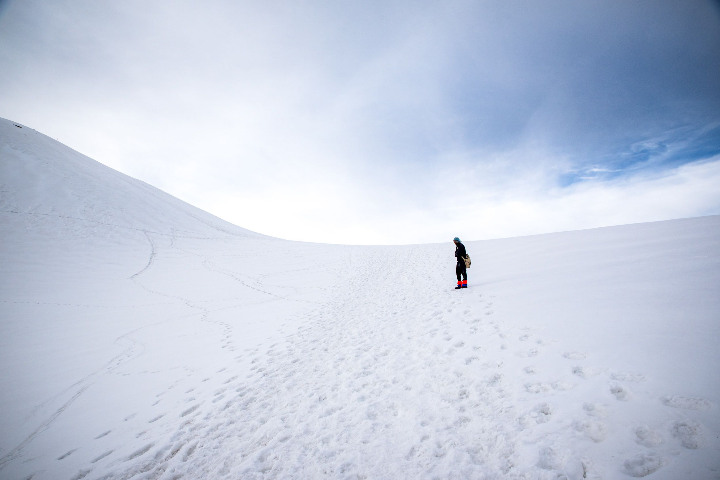
Itinerary
1
Day
Drive From Dehradun To Sankri Base Village (198 Kilometers, 8 Hours Drive )
2
Day
Trek from Sankri to Juda Ka Taal (4 Kilometers, 4 Hours Trek)
3
Day
Juda Ka Taal To Kedarkantha Base Camp (3 Kilometers, 3 Hours Trek)
4
Day
Trek To Kedarkantha Peak | Back To Juda ka Taal (9 Kilometers, 8 Hours Trek)
5
Day
Juda ka Taal To Sankri (4 Kilometers, 4 Hours Trek) | Back To Dehradun (8 Hours Drive)
Age Limit (Trip Wise)
Weekend
Getaways
18-38
Himalayan
Treks
18-48
Backpacking
Trips
18-40
Biking
Trips
18-45
Customized
Trips
No Limit
Inclusions & Exclusions
| Inclusions | Exclusions |
Accommodation: 1 Night in a Hotel / Homestay on a triple/quad sharing basis (with attached washroom and Geyser facility) and 3 Nights accommodation in a tent on a triple sharing basis. Transportation: Surface transfer from Dehradun - Sankri - Dehradun by Sumo / Bolero / Tempo Traveler ( Depends on the number of travelers). Meals: All Meals from (Day 1 Dinner to Day 5 Lunch) are included. We provide simple nutritious vegetarian food on all days of the trek. Snacks: Morning / Evening Tea / Coffee with light snacks and soup while on the trek. Camping logistics: Trekking tent, Sleeping bags, Mattresses, Dining tent, Kitchen tent and Toilet tent. Trek Leader Qualified and Experienced Trek leader and support staff. Permits: All necessary fees and permits.(For Indians) Trekking Equipment: Gaiters, Micro Spikes, and Rope if required. Safety Equipment: Walkie / Talkie , Basic First Aid kit with Oximeter, Blood Pressure Monitor and Oxygen Cylinder. Guide ratio: Local experience guide ( depends on the group size). Others : Cloak Room facility available at base camp for extra luggage. | Any expenses of personal nature. Meals during transit. Insurance of any kind. Unscheduled delay due to landslide. Cost Escalation due to “ Force Majeure and Evacuation charges”. Anything not mentioned explicitly in the above program. *You can apply for travel insurance prior to the trek. |
Cancellation Policy
| Upto 21 days | 20-15 days | 14-8 days | 7-0 days | |
| Batch Shifting | ||||
| Cancellation Charge | Free Cancellation | 25% of the Trip Amount | 50% of the Trip Amount | 100% of the Trip Amount |
| Booking Amount | Refunded in mode of Credit Note | Adjusted in Refund Deduction | Adjusted in Refund Deduction | No Refund |
| Remaining Amount | Full Refund (minus) booking amount | Refund (minus) 25% of the trip amount | Refund (minus) 50% of the trip amount | No Refund |
Payment Policy
| Upto 21 days | 21-15 days | 14-08 days | 07-03 days | |
|---|---|---|---|---|
| Booking Amount | ||||
| 50% Payment | Optional | Compulsory | ||
| 75% Payment | Optional | Optional | Compulsory | |
| 100% Payment | Optional | Optional | Optional | Compulsory |
Things To Pack
Rucksack:
You must pick a good quality backpack with a comfortable fit and straps that won’t give you shoulder pain. You can check out your nearest Decathlon store for a good trekking backpack.
You must pick a good quality backpack with a comfortable fit and straps that won’t give you shoulder pain. You can check out your nearest Decathlon store for a good trekking backpack.
Day Bag / Day Pack:
When you head towards the summit, you are required to carry only a few necessary items and for that, you need a day backpack as you will leave your bigger one on the campsite.
When you head towards the summit, you are required to carry only a few necessary items and for that, you need a day backpack as you will leave your bigger one on the campsite.
Hiking Shoes :
Durable footwear designed for rugged terrains.
Durable footwear designed for rugged terrains.
Floaters or Sandals:
Although the entire trek requires a good quality shoe, you still need to let your feet breathe to avoid chafing and blisters. When you are at the camp, a good pair of sandals and floaters will help you to move freely.
Although the entire trek requires a good quality shoe, you still need to let your feet breathe to avoid chafing and blisters. When you are at the camp, a good pair of sandals and floaters will help you to move freely.
Tees / Tshirts:
You must keep at least three pairs of quick dry tees so that you can wash them in between stops for proper hygiene.
You must keep at least three pairs of quick dry tees so that you can wash them in between stops for proper hygiene.
Poncho:
A poncho is an evolved form of a raincoat that provides coverage to your body as well as your bag and ensures total water protection from rain.
A poncho is an evolved form of a raincoat that provides coverage to your body as well as your bag and ensures total water protection from rain.
Quick Dry Towel:
A quick dry towel will help in maintaining proper hygiene. It must dry quickly because the wet fabric will only increase the chance of bacterial growth.
A quick dry towel will help in maintaining proper hygiene. It must dry quickly because the wet fabric will only increase the chance of bacterial growth.
Sanitizer:
Essential for maintaining cleanliness while trekking.
Essential for maintaining cleanliness while trekking.
Sun Cap / Hat:
A lightweight sun cap with side flaps is perfect to keep your head cool and avoid sunburns on a sunny day.
A lightweight sun cap with side flaps is perfect to keep your head cool and avoid sunburns on a sunny day.
Sunscreen SPF 40+:
To avoid sunburns and chafing, you need to put on sunscreen as well as cold cream.
To avoid sunburns and chafing, you need to put on sunscreen as well as cold cream.
Water Bottle (Re-usable):
Hydration is extremely important when it comes to trekking. Carrying a water bottle that you can refill with Himalayan water is a must.
Hydration is extremely important when it comes to trekking. Carrying a water bottle that you can refill with Himalayan water is a must.
Personal Toiletries:
A bag with all your essentials including napkins, toothpaste, sanitizers, paper soap, etc should be carried in a ziplock bag.
A bag with all your essentials including napkins, toothpaste, sanitizers, paper soap, etc should be carried in a ziplock bag.
Personal Medication / First Aid:
A few cuts and bruises are almost inevitable when you are on a trek so carrying a medical kit with bandages, Dettol, etc is necessary.
A few cuts and bruises are almost inevitable when you are on a trek so carrying a medical kit with bandages, Dettol, etc is necessary.
Sun Glasses / Reading Glasses:
Photochromatic glasses are specs that are designed to transform into anti-glare shades depending upon exposure to the sun. They are good when it comes to eye protection but one can also opt for clip-on glasses etc.
Photochromatic glasses are specs that are designed to transform into anti-glare shades depending upon exposure to the sun. They are good when it comes to eye protection but one can also opt for clip-on glasses etc.
Charger:
To keep your electronic devices powered during the trip.
To keep your electronic devices powered during the trip.
Power Bank:
Ensures your devices stay charged when there are no outlets.
Ensures your devices stay charged when there are no outlets.
Personal Documents & ID's:
Identification proofs like Aadhar Card, Drivers License.
Identification proofs like Aadhar Card, Drivers License.
Laundry Bag (Waterproof):
In case your clothes get wet or your garments don’t dry, you can carry them in polythene. However, make sure that all the plastic that you are carrying into the woods leaves with you. Don’t litter in the mountains.
In case your clothes get wet or your garments don’t dry, you can carry them in polythene. However, make sure that all the plastic that you are carrying into the woods leaves with you. Don’t litter in the mountains.
Track Pants:
A good pair of track pants made of polyester will let your skin breathe. They’re lightweight, dry easily, and comfortable to walk around in. You can easily avoid chafing and rashes by investing in a good pair of track pants.
A good pair of track pants made of polyester will let your skin breathe. They’re lightweight, dry easily, and comfortable to walk around in. You can easily avoid chafing and rashes by investing in a good pair of track pants.
Trekking Shoes:
A good trekking shoe is comfortable, provides ankle support, and has a good grip as well. They shouldn’t be chunky, instead, they should be lightweight and sturdy.
A good trekking shoe is comfortable, provides ankle support, and has a good grip as well. They shouldn’t be chunky, instead, they should be lightweight and sturdy.
Cotton Socks:
Cotton socks are extremely comfortable to move around in and are lightweight as well which is why you can always count on a good pair of cotton socks while trekking. However, keep in mind to change them and avoid wearing them when they are wet.
Cotton socks are extremely comfortable to move around in and are lightweight as well which is why you can always count on a good pair of cotton socks while trekking. However, keep in mind to change them and avoid wearing them when they are wet.
Woolen Socks:
A good pair of woolen socks, especially merino, are comfortable, limit odors and provide adequate insulation from the cold so you can wear them at night.
A good pair of woolen socks, especially merino, are comfortable, limit odors and provide adequate insulation from the cold so you can wear them at night.
Woolen Gloves:
Insulated gloves help in maintaining proper body heat in your hands and also provide a better grasp on trekking poles.
Insulated gloves help in maintaining proper body heat in your hands and also provide a better grasp on trekking poles.
Main Jacket:
It’s emphasized that you need to carry proper layers so you can avoid getting cold which is why you need to carry a heavy jacket that you can put on over your other clothes.
It’s emphasized that you need to carry proper layers so you can avoid getting cold which is why you need to carry a heavy jacket that you can put on over your other clothes.
Woolen Cap:
A woolen cap will help prevent cold when you ascend to high altitude. You can also cover your ears to avoid any pain and discomfort you might face in them when going at high altitudes.
A woolen cap will help prevent cold when you ascend to high altitude. You can also cover your ears to avoid any pain and discomfort you might face in them when going at high altitudes.
Hoodie:
A versatile layering option for various temperatures.
A versatile layering option for various temperatures.
Scarf / Balaclava:
Along with sun rays and chilly winds, you also get hit by dirt and grime during treks which is why it's important to carry a scarf or balaclava so you can cover your face when needed.
Along with sun rays and chilly winds, you also get hit by dirt and grime during treks which is why it's important to carry a scarf or balaclava so you can cover your face when needed.
Head Lamp:
You can’t rely on moonlight when you are in the mountains. A torch or even a headlamp with a fresh pair of batteries is always a good idea to bring along.
You can’t rely on moonlight when you are in the mountains. A torch or even a headlamp with a fresh pair of batteries is always a good idea to bring along.
Trekking Pole:
The trekking pole assists in more than one way. It saves energy while also providing stability and helps you to maintain proper balance.
The trekking pole assists in more than one way. It saves energy while also providing stability and helps you to maintain proper balance.
Camera:
This should be obvious. To make sure that you get to capture all the great moments from your trek. Make sure that you have enough storage and some extra batteries as well.
This should be obvious. To make sure that you get to capture all the great moments from your trek. Make sure that you have enough storage and some extra batteries as well.
Riding Gear:
If your trip involves biking or motorcycling.
If your trip involves biking or motorcycling.
Moisturiser & Cold Cream:
To avoid sunburns and chafing, you need to put on sunscreen as well as cold cream.
To avoid sunburns and chafing, you need to put on sunscreen as well as cold cream.
Lip Balm:
Your lips can become chapped due to the harsh cold winds so it's important to keep them moisturized.
Your lips can become chapped due to the harsh cold winds so it's important to keep them moisturized.
Sanitary Pads:
Essential for feminine hygiene.
Essential for feminine hygiene.
Insect Repellent:
Guards against pesky bugs and insects.
Guards against pesky bugs and insects.
Cash:
Emergency funds for unexpected situations.
Emergency funds for unexpected situations.
Thermals:
Thermal is a piece of garment that helps in keeping your body warm in cold temperatures. It is a necessary item that you need when going on a high-altitude trek.
Thermal is a piece of garment that helps in keeping your body warm in cold temperatures. It is a necessary item that you need when going on a high-altitude trek.
Snacks / Dryfruits / Energy Bar:
Provides quick energy on the go.
Provides quick energy on the go.
Positive Attitude:
The most important item for a successful trek or trip, keeping your spirits high and adaptable to the challenges of the journey.
The most important item for a successful trek or trip, keeping your spirits high and adaptable to the challenges of the journey.
Why Trek with JustWravel
Choosing the right trek is easy, but selecting the right trekking company is the real challenge, especially when venturing into the remote areas of the Himalayas. The experience and credibility of a trekking organization are crucial factors you need to consider. We understand these concerns, and that’s why we want to show you why JustWravel is your ideal trekking partner for the Kedarkantha Trek.
Put on your Shark Tank sunglasses because, after our pitch, you'll be eager to pack your bags for the Kedarkantha Trek!
- The Safest Travel Community in India: For us, safety comes first, and the fun, adventure, and thrill of a trek come later.
- From the Mountains with Love: Yes, that’s us. Most of our trekking coordinators are from the mountains; they share year-round knowledge of how pahadi life is. Nobody knows the mountains better than the people who have grown up playing on its slopes. To ensure you have the safest and most enthralling experience, we make sure to hire local guides. Most of our vendors are also natives, which assures an exchange of healthy and profitable business on both ends.
- Certified Trek Captains: Our Trek Captains are both BMC and AMC (Advanced Mountaineering Course) certified and are highly skilled medics. They know every nook and cranny of the trail and are equipped with extensive knowledge to handle any situation.
- The Experience of Years: Our knowledge is not merely theoretical. We ventured into the mountains years ago, and through our experiences, we’ve learned valuable lessons that we pass on to our trekkers.
- Taking What We Took There: This is what sets us apart in the market. We never litter the mountains. What we bring to the mountains, we take back for sure. Read below to learn more about our Keep The Trails Alive campaign.
Keep The Trails Alive
Don’t be a Crap Bag
You are in nature’s lap
Kindly take that garbage back
If you’re wondering what our Keep the Trails Alive campaign is all about, it’s simple: without proper management, many sacred mountains are facing littering due to over-tourism. As responsible trekkers, we will never let that happen. If you’re trekking with JustWravel, you need to ensure that everything you carry in, you carry out. We will never leave anything behind except our love and a piece of our hearts for the majestic views we experience.
- Reusable: Always carry your own water bottle and cutlery to reuse them.
- Carry Out What You Carry In: Always pack out all your waste, including food wrappers, bottles, tissues, and sanitary items. Never leave anything behind.
- Use Toilet Tents and Dig Pits: Bury human waste in deep pits (6+ inches) to prevent contamination. Dispose of toilet paper and sanitary waste in your trash bag.
- Manage Food Waste Carefully: Bury leftover food and peels away from water sources. Avoid feeding wildlife to prevent dependency.
- Dispose of Waste Properly: Carry out all waste and dispose of it responsibly at designated collection points or in towns. Avoid burning waste.
- Avoid Polluting Water Sources: Wash dishes, clothes, and yourself away from streams and lakes. Use biodegradable soap sparingly.
- Educate Yourself and Others: Learn local waste management practices and follow them. Teach fellow trekkers and porters about responsible disposal.
Everything You Need To Know About JW Trekking
Dry Pits
Dry pits are a crucial waste management solution in trekking environments, particularly in remote areas where traditional plumbing is unavailable. These systems consist of deep holes dug into the ground, designed to safely contain human waste. The primary benefit of dry pits is their ability to facilitate the natural decomposition of waste, which minimizes the environmental impact associated with human activity in pristine natural areas. By using dry pit systems, trekkers help protect water sources from contamination. The implementation of dry pits not only improves hygiene for trekkers by providing designated areas for sanitation but also promotes awareness and education about sustainable practices within local communities.
Bathing
While the idea of bathing after a long day of trekking may seem appealing, it is generally discouraged for several important reasons. As trekkers ascend to higher altitudes, they encounter significantly colder temperatures, especially at night. Bathing in cold water can lead to rapid heat loss, particularly in vulnerable areas such as the legs and head, increasing the risk of hypothermia. Additionally, access to bathing facilities is often limited in remote trekking areas, making it impractical and unsafe. Engaging in bathing can also cause the body to expend extra energy to maintain its core temperature, which may hinder the acclimatization process necessary for high-altitude trekking. Instead, most trekking itineraries include a stop at a base camp where trekkers can enjoy warmer conditions and facilities for bathing, allowing for a more comfortable and safer experience.
Bonfire
Bonfires are typically prohibited during treks for several compelling reasons that prioritize environmental conservation and safety. One of the main concerns is the environmental impact of gathering firewood, which can lead to deforestation and habitat destruction in ecologically sensitive areas. Removing wood from these environments disrupts local ecosystems and can have long-lasting effects on biodiversity. Additionally, open fires pose a significant risk of attracting wildlife, including potentially dangerous animals such as bears. The smell of food and smoke can draw these creatures closer to campsites, increasing the likelihood of dangerous encounters for trekkers.
Vegetarian Food
Providing vegetarian meals during treks is a deliberate choice that offers numerous benefits. Vegetarian food is generally easier to store and prepare in remote areas, as ingredients like lentils, beans, and grains have longer shelf lives and require less refrigeration. This practicality is crucial in environments where access to resources is limited. Additionally, vegetarian meals minimize the risk of attracting wildlife to campsites, which can be a significant safety concern. Non-vegetarian food can draw animals closer, creating potential dangers for trekkers. Vegetarian meals can be highly nutritious, offering essential vitamins, minerals, and protein that are vital for sustaining energy during physically demanding treks. Ingredients such as nuts, seeds, and legumes are energy-dense and provide the necessary fuel for trekkers. Lastly, vegetarian cuisine can be diverse and flavorful, incorporating local ingredients and spices that enhance the trekking experience, allowing trekkers to enjoy a variety of delicious dishes while minimizing their environmental impact.
Plan B and C
Having contingency plans, often referred to as Plan B and C, is a vital aspect of trekking, especially in mountainous regions where conditions can change unexpectedly. The weather in these environments can be unpredictable, with storms, snow, or high winds potentially altering planned routes. By preparing alternative plans, trekkers can adapt to changing conditions and ensure their safety. Experienced trekking organizations emphasize the importance of these backup plans, as they allow for swift responses in the event of emergencies, such as injury or illness. This adaptability is crucial for maintaining the safety and comfort of all participants. With years of trekking experience, guides develop a keen understanding of the mountains and can assess conditions effectively, ensuring that trekkers remain safe and comfortable throughout their journey. Ultimately, being prepared with multiple plans enhances the overall trekking experience, allowing trekkers to enjoy their adventure with the confidence that they can navigate any challenges that may arise.
Acclimatization
Acclimatization is a critical process that allows trekkers to adjust to the physiological changes that occur when ascending to high altitudes. As trekkers gain elevation, the body must adapt to decreased oxygen levels and lower atmospheric pressure to prevent altitude sickness, which can occur if one ascends too quickly without allowing sufficient time for adjustment. Effective acclimatization involves a gradual ascent, ideally limiting elevation gain to no more than 300-500 meters (about 1,000-1,600 feet) per day above 3,000 meters (approximately 9,800 feet). This slow increase allows the body to adapt to the changing environment. Staying well-hydrated is also essential, as dehydration can exacerbate symptoms of altitude sickness; trekkers should aim to drink at least 3-4 liters of water daily. Incorporating rest days at higher altitudes is another important strategy, as these days allow the body to adjust while engaging in light activities. Trekkers should also be attentive to their bodies, recognizing the signs of altitude sickness, which may include headaches, nausea, dizziness, and fatigue. If symptoms arise, descending to a lower altitude is often the most effective course of action. Lastly, consuming a balanced diet rich in carbohydrates can help provide the energy needed for acclimatization, with foods that are easy to digest and high in calories being particularly beneficial during treks. Understanding and implementing these key aspects of acclimatization can significantly enhance the safety and enjoyment of trekking experiences in high-altitude environments.
VIDEOS
Memories for Life
posts
Instagram Images
REVIEWS
What our Clients Say About Us
blogs
Our Blogs

Published on 7 Dec
17 minutes read
Kedarkantha Trek Itinerary : The Perfect Winter Escapade
17 minutes read
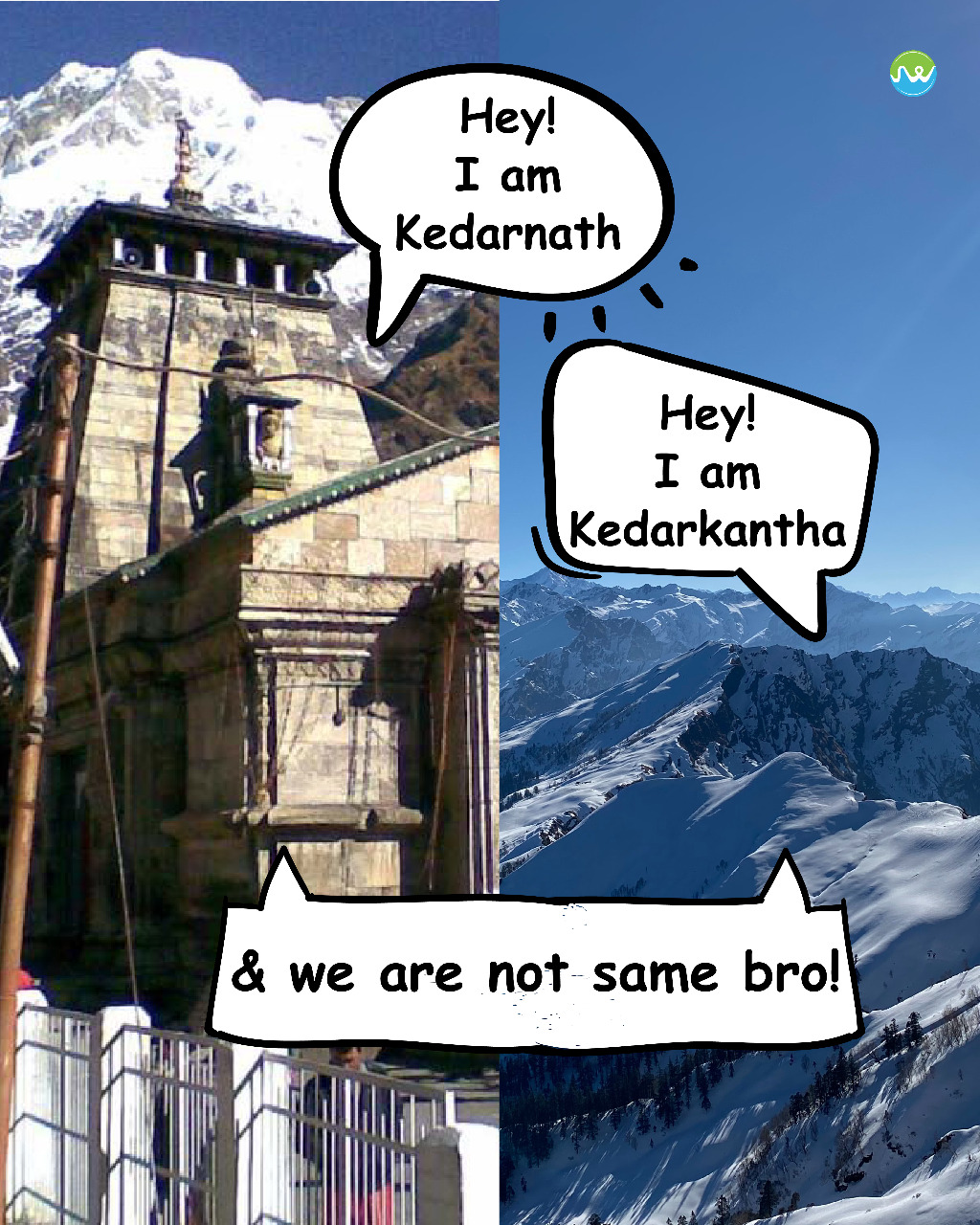
Published on 13 Oct
8 minutes read
Confused Between Kedarkantha and Kedarnath? Check How They Are Different From Each Other
8 minutes read
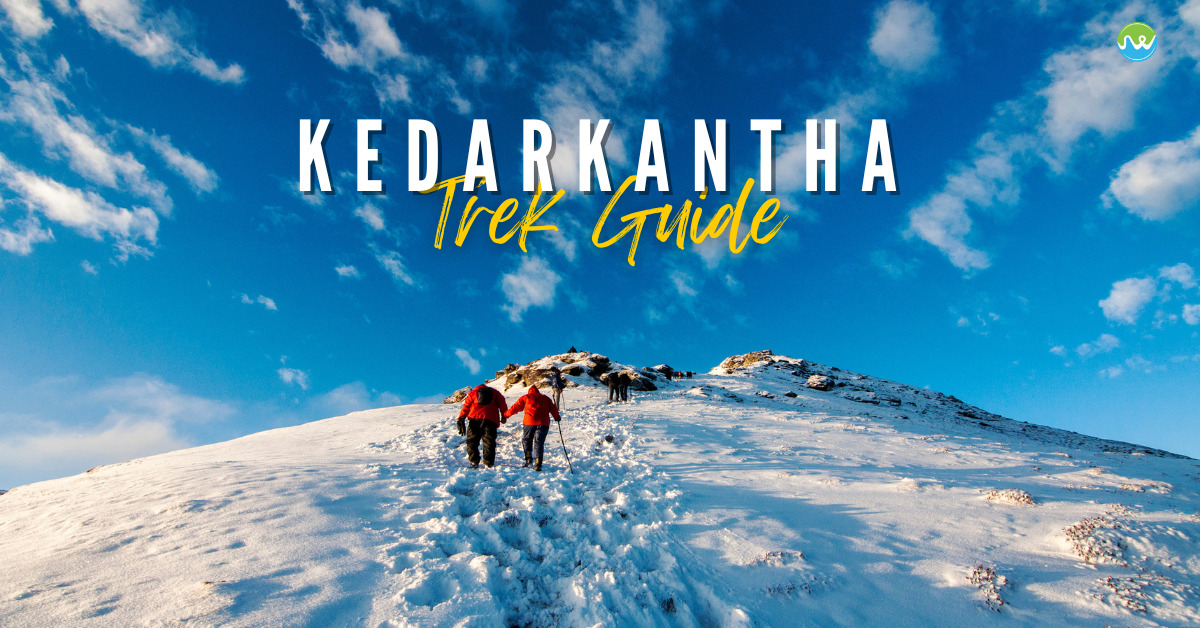
Published on 20 Nov
28 minutes read
Kedarkantha Trek 2024: A Complete Guide
28 minutes read
Faq
Have any Doubts
When is the best time to go to Kedarkantha trek?
Except for the monsoon season, there aren’t any restrictions when it comes to this trek. The ideal time is from December till the middle of March. For snow fanatics, the best time is from December till the middle of April.
How long is the Kedarkantha trek?
The distance that we cover in this trek is around 20 Kms.
Where is the Kedarkantha trek located?
Kedarkantha trek is located in Sankri region in Uttarkashi district (Uttarakhand).
What gear is necessary to carry for the Kedarkantha trek?
We share an extensive list of all the necessary items you will need for this trek once your booking is done.
Which type of shoes are required for the Kedarkantha trek?
Good quality shoes are always recommended for trekking. You need to be careful about your purchase and make sure that the soles have a good grip and that the shoes are water repellent/waterproof with high ankle length.
We recommend you to check out Decathlon.
How to get safe drinking water on the treks?
Himalayan water is considered the purest water there is and is totally safe to drink. But for health purposes, we boil the water or use chlorine tablets before drinking or cooking with it.
In case you find a clean resource for water while trekking, make sure that you store it from a place where it’s running from instead of from a stagnant water body.
Can I take my child along on this trek? What is the age limit?
The minimum age limit for the Kedarkantha Trek is at least 18 years. However, in case a minor wants has to join with his/her family, they have to be atleast be 13 year old. Parental advisory and companionship is necessar for anyone below 18 years.
How can I book the Kedarkantha trek with you?
After selecting the trip/trek, you can book your slots by clicking on the 'Book now’ button or you can contact us directly and we will guide you through the process.
What type of on ground transportation is used in this trek?
Depending on the number of participants, We use cars like Bolero / Sumo / Innova / or Tempo Traveller.
What are the washroom/toilet facilities like on the Kedarkantha trek?
In Sankri base camp, we have Homestay with Western toilet facility. During the trek, we use separate dry pit toilets for Males and Females.
Read More: Kedarkantha Trek Guide
Will a doctor accompany us on the trek?
No, but all of our trek leaders are certified and have done the Wilderness First Aid course. They always carry a first aid kit, Oximeter and oxygen cylinders on high altitude treks.
How many trekkers will be in one tent?
It depends entirely on the group dynamics. If there is a couple traveling with us, we can give them a separate tent for privacy reasons. If there are an odd number of people, then there would be triple sharing.
If I cannot carry my rucksack/bag on the trek, can I offload it?
We always recommend that you carry your rucksack during the trek because it helps in maintaining your body posture. In case you cannot, then we can provide you a mule/porter to carry your rucksack to relieve you of your baggage. You will have to inform us at least 1 week before the trek and the charges for offloading would be INR 1200 per person per bag for the entire program. Extra charges would be applied if your rucksack weighs more than 10kg.
Should we bring some medicines with us?
Yes, it is always advisable to carry your own medical kit with medications for headaches, nausea, etc.
What type of food is served during the trek?
It’s extremely important to make sure that you eat nutritious food so you can maintain your energy during the trek. We serve eggs to make sure you get proper protein intake and serve different kinds of Indian cuisine.
How difficult is the Kedarkantha trek?
Kedarkantha trek comes in the easy to moderate category and the variation depends entirely on the weather.
How to reach Kedarkantha base village?
Generally, transportation from Dehradun to Sankri and back is included in Justwravel Package but if you opt for traveling on your own, then you will have to reach Sankri village, which is the base camp for the Kedarkantha Trek. In order to reach Sankri Village, you can take a Private cab/Sharing vehicle from Dehradun Railway station. Public Buses are also available in the morning but in limited numbers and are often unreliable.
Read More: Kedarkantha Trek Guide
I am the only girl in the group, is it safe for me to travel / trek solo?
Definitely! One of the most integral priorities of our treks and trips is the safety of women. Every person going on this excursion is carefully handpicked to avoid any kind of trouble. However, you will still need to take care of your personal belongings.
Why is the Kedarkantha trek the best winter trek?
There are many reasons why ‘Kedarkantha Trek' is considered to be one of the best winter treks but some of the most significant ones are that this trek is easy to do, is budget friendly, and ends with a picturesque view of snow-capped peaks that leaves the travelers feeling content. It also gives you an opportunity to learn more about Pahari customs and culture.
Can you customize the Kedarkantha trek?
Yes, it’s customizable but it depends if what you are asking for is something we can afford to deliver.
Who will go along with us during the trek?
All our expeditions are led by professional trek leaders who are certified mountaineers and have years of experience. Apart from them, there will be a local guide, cook, helper and other staff for your convenience.
Can we change the itinerary?
Yes, we can make changes to some extent but only if we find your suggestions and demands feasible.
Read more about the Itinerary https://www.justwravel.com/blog/kedarkantha-trek-itinerary/
TRIPS
Related Trips





Kedarkantha Trek
Details
Inclusions
Safe Travel
Flexible Cancellation
Easy EMI
Certified Captains
24/7 Support
Overview
The Queen of Winter Treks, Kedarkantha Trek is undoubtedly the first choice that comes to mind when you think of winter trekking. Kedarkantha is sometimes known as "Kedar Khand," which is a name of historical significance in the area that roughly means "Section of Lord Shiva." Nevertheless, Kedarkantha means "Throat of Lord Shiva." As per the legend, Lord Shiva used to meditate in Kedarkantha before moving to Kedarnath.
Elevated at 12,500 ft, Kedarkantha is one of the breathtaking peaks of the whole majestic Himalayan range. Out of all the best winter treks in India, Kedarkantha Trek is the most popular choice attracting thousands of hikers and trekkers across the country. It is suitable for everyone from novice trekkers to those who are experts.
This 4-night, 5-day Kedarkantha trek is organized to cater to those who prefer to be in calm nature with unpredictable paths and mysterious valleys with a love for adventure. Famous for its awe-inspiring sight of snow-covered mountains, the summit gives a fleeting look at several ranges, namely Black Peak, Swargarohini, Gangotri, and Yamunotri. The summit's name means Lord Shiva's Throat and its association with Lord Shiva, and the stories and folklores that come from the locals add to its beauty and mix the experience.
JustWravel’s Kedarkantha Trek will kick off at Dehradun then we will navigate through a tiny village Sankri which is the base camp for this long trek of 20 kilometers. We will spend a night at our designated homestay or hotel, introducing ourselves and sharing experiences, before going to bed for the night. The next day, after a briefing session from our trek leader, we will go to our first checkpoint, Juda Ka Taal, where we will spend the day at the campsite, enjoying lunch and dinner while looking at the Swargarohini ridges.
The following day, we will carry on our trek to the Kedarkantha base camp positioned at 11,200 ft above sea level. After a hot lunch and doing some random activities such as snowball fights, we will start our overnight stay at the base camp itself.
After enduring the highs and lows of this short trek and watching the magical sunsets, we will make our final trek to the Kedarkantha summit before dawn. One of the most memorable moments of this trek is the early sunrise at the top which will make you forget about your weariness and put you in complete tranquility. One thing that sets the Kedarkantha trek apart is that it is classified as a moderately difficult trek. It is beginner-friendly and gives trekkers a chance to enjoy the splendid 360-degree view of the majestic Himalayan ranges thus, making the experience of trekking all the more enjoyable. The coldest place along the trekking route is Juda Ka Taal where during the winter months the lake is frozen completely. The sun glimmers on its surface like diamonds causing it to have a golden coloration. The trek gets more interesting as you proceed, with enchanting landscapes along the way. If the weather gods are kind, you may find yourself amidst the snowfall. A large number of people who go to Kedarkantha Trek continue coming back, not only for the summit but also for the culture and cuisine. Apart from the peaked rice variety which is one of the specialties of the Kedarkantha region, you have to try the well-cooked red rice as it assists the body stay warm during winters.
The carrying of electronic devices that work only with a network connection is not advisable. The network is lost just before arriving at Sankri Village, the starting point of the trek. Although the Kedarkantha trek is accessible year-round, most people prefer to visit during winter to witness the pristine snow, particularly in December and January. The best time to visit Kedarkantha is from November to February. It is one of those places where the full essence of the experience cannot be captured on the first visit, so trekkers often return. In conclusion, based on popular opinion and its widespread appeal, the Kedarkantha trek can be easily categorized as ‘The Best Winter Trek in India’. If you’re overwhelmed by multiple winter trek options in India and unsure of which to choose, Kedarkantha should be an easy decision.
So, make some room for the Kedarkantha Trek in your 2024 travel bucket list, and keep your backpack ready for this winter season.
How to Reach Kedarkantha Trek
- By Air: The closest airport to the Kedarkantha Trek is Jolly Grant Airport in Dehradun, located approximately 25 kilometers away. There is a daily flight from Delhi to Dehradun. Once you reach Dehradun, you can either hire a taxi or use public transportation to reach the base camp Sankri.
- By Train: If you are coming from Delhi to Kedarkantha, you have the option to take a train to Dehradun. There are frequent trains connecting Delhi and Dehradun, so you can choose to travel overnight. Upon reaching Dehradun, you can then take a private vehicle or a bus to Sankri.
- By Road: Regular bus services are available from Delhi to Dehradun. It is recommended to take a Delhi government bus from Kashmere Gate to Dehradun. Once you arrive in Dehradun, you can either use public transportation or rent a private vehicle to reach Sankri.
Extended Read: How To Reach Kedarkantha
Best Time to Visit Kedarkantha Trek
The Kedarkantha trek is unique among the Indian Himalayas as it can be done all year round, except for July and August when it is closed due to heavy rainfall. The trek is divided into four seasons, each offering its own distinct terrain, difficulty, and weather conditions.
Winter – November to March
During November, December, January, and February, the Kedarkantha Trek is famous for its winter journey. The snow-covered landscapes and thrilling summit ascent make it a popular choice, especially for beginners. You will trek through deep snow-covered forests and set up camps in clearings amidst the snowdrifts.
Spring
In March and April, Kedarkantha still retains a significant amount of snow, particularly in the upper campgrounds near the summit. The blooming rhododendrons and newly exposed grasses create a stunning contrast against the snowy backdrop as you ascend higher. By April, most of the snow has melted, and Kedarkantha comes alive with the beautiful scenery after its winter slumber.
Summer
May and June bring the brilliant morning sun to Kedarkantha. The nights are not as cold as in other months, and there is a lower chance of rainfall. This is also the time when the trail is less crowded, as most people have moved on to higher-altitude hikes. If you prefer a more solitary experience, May and June are the perfect months to visit.
Monsoon
September, October, and November mark the post-monsoon season when the entire journey comes to life. The meadows and forests are fresh and vibrant, and the air is crisp. The upper Himalayan vistas are breathtaking during these months.
Read More: Best Time to Visit Kedarkantha Trek
Why Kedarkantha Trek is the Best Winter Trek
If you've ever pondered which Indian winter trek is the greatest, Kedarkantha's name has probably come up. If you're wondering why people go to Kedarkantha, the five main attractions are the snow, forest, frozen lake, 360-degree summit view, and camping experience. The unmatched splendor of the Kedarkantha Trek in the winter is what makes it unique.
- Winter Wonderland: Kedarkantha Trek is one of the best winter treks in the Himalayas, being beautiful with snow-covered peaks and chilly nights.
- Mind-Bending Camping Adventure: During the Kedarkantha Trek, you can camp at some really cool and unique campsites with great mountain views and a close relationship with nature.
- Frozen Forests: Trekking through the dense Himalayan coniferous forests and glacial landscapes you will learn to camp in the captivating winter scenes.
- Frozen Lake - Juda Ka Taalab: Juda Ka Taalab is a frozen lake of extraordinary beauty that you should spend time on because it will be a peaceful place to meditate and take photos.
- Beginner-Friendly Trek: Kedarkantha Trek is the best option for you as a beginner offering a harmonious blend of natural beauty and thrilling adventure.
- Summit Climb: If you want a real excitement kick, try a summit climb and walk on thick layers of snow to the top.
- Panoramic Views of the Himalayas: Above the clouds, there are stunning views of the various mountain peaks from Kedarkantha Trek, including the peaks of the beautiful Gangotri, Bandarpoonch, Kalanag, Yamunotri, and the Swargarohini range.
- Photographer's Paradise: The landscapes of Kedarkantha Trek will be indescribable as if you are living on a postcard. So, you will have an endless number of breathtaking photography opportunities out there.
What is the difficulty level of the Kedarkantha Trek?
The Kedarkantha Trek is categorized as easy to moderate. A 20 km hike rises from 6,400 feet to 12,500 feet, which is a suitable choice for beginners who are looking to discover the magnificent Himalayas. The summit day is exacting, and it is usually a 7-8 hours trek that includes 5 hours of constant ascent and then 2-3 hours of descent. This can be a drainer, hence a reasonable degree of fitness is vital for one to finish the day without any strain.
Due to the trek's relatively short length, you will be able to embrace the stunning vistas and take pictures that will stick in your mind for a lifetime thus making your trekking experience more pleasant. When you get to the summit and see the other peaks around you at eye level, you will not only experience a profound sense of humility but also satisfaction. Kedarkantha is a solo mountain with many routes to the top, which increases the thrill while at the same time ensuring safety with various exit points - a great asset, especially for solo trekkers. The trip has numerous characteristics of an easy one but the length and steepness of the summit climb are the reasons for its classification being easy-moderate.
Suggested Read: What is the difficulty level of Kedarkantha Trek
The Story of Kedarkantha
The Kedarkantha trek has a rich spiritual history, placed in priestly bondage with the legends of the god Lord Shiva. To local folklore, this peak could be addressed as the place of meditation by Lord Shiva. However, he moved his meditation to Kedarnath after being disturbed by a bull that was roaming around. At the height of Kedarkantha, trekkers could find a small shrine built by Lord Shiva, it is now a historical monument proving the legend. Besides being an attractive mountain peak where visitors can view the superlative panorama covering many of the majestic ranges, its spiritual claims also make it a revered site for trekking devotees.
There is another story linked to Kedarkantha, which deals with the Pandavas of Mahabharata. They were said to have gotten the approval of the bull god who happened to be a disguise used by Shiva, when they were looking for his blessing. When Bheem recognized him and tried to take him, Shiva went underground, thereby causing the parts of his body to separate and fall at different locations. It is believed that the throat of Lord Shiva fell at Kedarkantha, thus, the peak gets its name for which it is called Kedar Kantha, the throat of Lord Shiva. This relationship not only considers the trek as more spiritually important but also has a historical background in Hindu mythology, thus, Kedarkantha is a place where seeking thrills is blended with reverence.
How To Prepare For Kedarkantha Trek
Preparing for the Kedarkantha trek involves a mixture of physical conditioning, gear selection, and route familiarity to ensure a safe and enjoyable experience. Here are the essential steps to help you get ready:
Physical Preparation
The Kedarkantha trek is a trip of medium difficulty, therefore, it is important to be in good physical shape. Seek ways to improve your cardiovascular health with exercises such as jogging, biking, or vigorous walking for instance. Include strength training specializing in the legs and core to be able to walk in multiple areas without any difficulty. Be moving for 4-5 kilometers every day until you really get used to it. The slow rise is the main factor for acclimatization. Make your route a little longer to include some gradual ascents, as this will give your body the chance to adapt to the higher altitudes. Drink sufficient fluids and don't consume alcohol in order to avoid altitude sickness.
Gear and Packing
For Kedarkantha Trek, make sure you have tough footwear with a good grip, warm clothes, and a rugged backpack. Layering is the key; along with the pack you should have waterproof and windproof jackets, thermal innerwear, and moisture-wicking fabrics. You should take along also things like gloves, hats, sunglasses, and a sleeping bag as well as warm and comfortable ones. Opt for a smaller backpack and only take the things you really need. Make sure the weight is distributed equally for better balance and comfort during the walk.
Route Familiarization
Try to learn how to go from Sankri Base Camp to Kedarkantha Peak by yourself. Being aware of the trail will allow you to find your way easily, and you will not get lost. A well-detailed map or GPS device can be used as a guide for the route. Get weather updates before you start your trek so you can be ready for the changing weather, especially in the winter when there will be snow on the trails that can make them slippery.
Safety Measures
It is possible to do a trek by yourself, but getting a guide can make it more secure and easier. A skilled guide can help you navigate the difficult terrain, find places to stay, and tell you about local customs. Bring essential first aid supplies that consist of painkillers, blister plasters, antiseptic creams, and any personal medicines you may need.
Mental Preparation
You should be ready to face obstacles such as steep hills or erratic weather. Get into the spirit of the journey with an open heart and have a blast while it lasts.
By strictly following these guidelines and preparing in advance you can make sure that your Kedarkantha trek is not only safe but also an unforgettable experience amidst the stunning Himalayan landscapes.
Be ready to witness the best sunrise in Kedarkantha Trek…
Itinerary
1
Day
Drive From Dehradun To Sankri Base Village (198 Kilometers, 8 Hours Drive )
2
Day
Trek from Sankri to Juda Ka Taal (4 Kilometers, 4 Hours Trek)
3
Day
Juda Ka Taal To Kedarkantha Base Camp (3 Kilometers, 3 Hours Trek)
4
Day
Trek To Kedarkantha Peak | Back To Juda ka Taal (9 Kilometers, 8 Hours Trek)
5
Day
Juda ka Taal To Sankri (4 Kilometers, 4 Hours Trek) | Back To Dehradun (8 Hours Drive)
Age Limit (Trip Wise)
Weekend
Getaways
18-38
Himalayan
Treks
18-48
Backpacking
Trips
18-40
Biking
Trips
18-45
Customized
Trips
No Limit
Pricing
Select Occupancy
+5% GST *

Batches
Accommodation: 1 Night in a Hotel / Homestay on a triple/quad sharing basis (with attached washroom and Geyser facility) and 3 Nights accommodation in a tent on a triple sharing basis. Transportation: Surface transfer from Dehradun - Sankri - Dehradun by Sumo / Bolero / Tempo Traveler ( Depends on the number of travelers). Meals: All Meals from (Day 1 Dinner to Day 5 Lunch) are included. We provide simple nutritious vegetarian food on all days of the trek. Snacks: Morning / Evening Tea / Coffee with light snacks and soup while on the trek. Camping logistics: Trekking tent, Sleeping bags, Mattresses, Dining tent, Kitchen tent and Toilet tent. Trek Leader Qualified and Experienced Trek leader and support staff. Permits: All necessary fees and permits.(For Indians) Trekking Equipment: Gaiters, Micro Spikes, and Rope if required. Safety Equipment: Walkie / Talkie , Basic First Aid kit with Oximeter, Blood Pressure Monitor and Oxygen Cylinder. Guide ratio: Local experience guide ( depends on the group size). Others : Cloak Room facility available at base camp for extra luggage. |
Cancellation Policy
Credit Note :
The Booking Amount will be credited to your JW Profile which can be accessed by logging in to the website through your Email ID. Credit Notes issued have no date of expiry and can be used entirely in any of your future trips.
GST :
The Booking Amount will be credited to your JW Profile which can be accessed by logging in to the website through your Email ID. Credit Notes issued have no date of expiry and can be used entirely in any of your future trips.
Payment Policy
Things To Pack
Rucksack:
You must pick a good quality backpack with a comfortable fit and straps that won’t give you shoulder pain. You can check out your nearest Decathlon store for a good trekking backpack.
You must pick a good quality backpack with a comfortable fit and straps that won’t give you shoulder pain. You can check out your nearest Decathlon store for a good trekking backpack.
Day Bag / Day Pack:
When you head towards the summit, you are required to carry only a few necessary items and for that, you need a day backpack as you will leave your bigger one on the campsite.
When you head towards the summit, you are required to carry only a few necessary items and for that, you need a day backpack as you will leave your bigger one on the campsite.
Hiking Shoes :
Durable footwear designed for rugged terrains.
Durable footwear designed for rugged terrains.
Floaters or Sandals:
Although the entire trek requires a good quality shoe, you still need to let your feet breathe to avoid chafing and blisters. When you are at the camp, a good pair of sandals and floaters will help you to move freely.
Although the entire trek requires a good quality shoe, you still need to let your feet breathe to avoid chafing and blisters. When you are at the camp, a good pair of sandals and floaters will help you to move freely.
Tees / Tshirts:
You must keep at least three pairs of quick dry tees so that you can wash them in between stops for proper hygiene.
You must keep at least three pairs of quick dry tees so that you can wash them in between stops for proper hygiene.
Poncho:
A poncho is an evolved form of a raincoat that provides coverage to your body as well as your bag and ensures total water protection from rain.
A poncho is an evolved form of a raincoat that provides coverage to your body as well as your bag and ensures total water protection from rain.
Quick Dry Towel:
A quick dry towel will help in maintaining proper hygiene. It must dry quickly because the wet fabric will only increase the chance of bacterial growth.
A quick dry towel will help in maintaining proper hygiene. It must dry quickly because the wet fabric will only increase the chance of bacterial growth.
Sanitizer:
Essential for maintaining cleanliness while trekking.
Essential for maintaining cleanliness while trekking.
Sun Cap / Hat:
A lightweight sun cap with side flaps is perfect to keep your head cool and avoid sunburns on a sunny day.
A lightweight sun cap with side flaps is perfect to keep your head cool and avoid sunburns on a sunny day.
Sunscreen SPF 40+:
To avoid sunburns and chafing, you need to put on sunscreen as well as cold cream.
To avoid sunburns and chafing, you need to put on sunscreen as well as cold cream.
Water Bottle (Re-usable):
Hydration is extremely important when it comes to trekking. Carrying a water bottle that you can refill with Himalayan water is a must.
Hydration is extremely important when it comes to trekking. Carrying a water bottle that you can refill with Himalayan water is a must.
Personal Toiletries:
A bag with all your essentials including napkins, toothpaste, sanitizers, paper soap, etc should be carried in a ziplock bag.
A bag with all your essentials including napkins, toothpaste, sanitizers, paper soap, etc should be carried in a ziplock bag.
Personal Medication / First Aid:
A few cuts and bruises are almost inevitable when you are on a trek so carrying a medical kit with bandages, Dettol, etc is necessary.
A few cuts and bruises are almost inevitable when you are on a trek so carrying a medical kit with bandages, Dettol, etc is necessary.
Sun Glasses / Reading Glasses:
Photochromatic glasses are specs that are designed to transform into anti-glare shades depending upon exposure to the sun. They are good when it comes to eye protection but one can also opt for clip-on glasses etc.
Photochromatic glasses are specs that are designed to transform into anti-glare shades depending upon exposure to the sun. They are good when it comes to eye protection but one can also opt for clip-on glasses etc.
Charger:
To keep your electronic devices powered during the trip.
To keep your electronic devices powered during the trip.
Power Bank:
Ensures your devices stay charged when there are no outlets.
Ensures your devices stay charged when there are no outlets.
Personal Documents & ID's:
Identification proofs like Aadhar Card, Drivers License.
Identification proofs like Aadhar Card, Drivers License.
Laundry Bag (Waterproof):
In case your clothes get wet or your garments don’t dry, you can carry them in polythene. However, make sure that all the plastic that you are carrying into the woods leaves with you. Don’t litter in the mountains.
In case your clothes get wet or your garments don’t dry, you can carry them in polythene. However, make sure that all the plastic that you are carrying into the woods leaves with you. Don’t litter in the mountains.
Track Pants:
A good pair of track pants made of polyester will let your skin breathe. They’re lightweight, dry easily, and comfortable to walk around in. You can easily avoid chafing and rashes by investing in a good pair of track pants.
A good pair of track pants made of polyester will let your skin breathe. They’re lightweight, dry easily, and comfortable to walk around in. You can easily avoid chafing and rashes by investing in a good pair of track pants.
Trekking Shoes:
A good trekking shoe is comfortable, provides ankle support, and has a good grip as well. They shouldn’t be chunky, instead, they should be lightweight and sturdy.
A good trekking shoe is comfortable, provides ankle support, and has a good grip as well. They shouldn’t be chunky, instead, they should be lightweight and sturdy.
Cotton Socks:
Cotton socks are extremely comfortable to move around in and are lightweight as well which is why you can always count on a good pair of cotton socks while trekking. However, keep in mind to change them and avoid wearing them when they are wet.
Cotton socks are extremely comfortable to move around in and are lightweight as well which is why you can always count on a good pair of cotton socks while trekking. However, keep in mind to change them and avoid wearing them when they are wet.
Woolen Socks:
A good pair of woolen socks, especially merino, are comfortable, limit odors and provide adequate insulation from the cold so you can wear them at night.
A good pair of woolen socks, especially merino, are comfortable, limit odors and provide adequate insulation from the cold so you can wear them at night.
Woolen Gloves:
Insulated gloves help in maintaining proper body heat in your hands and also provide a better grasp on trekking poles.
Insulated gloves help in maintaining proper body heat in your hands and also provide a better grasp on trekking poles.
Main Jacket:
It’s emphasized that you need to carry proper layers so you can avoid getting cold which is why you need to carry a heavy jacket that you can put on over your other clothes.
It’s emphasized that you need to carry proper layers so you can avoid getting cold which is why you need to carry a heavy jacket that you can put on over your other clothes.
Woolen Cap:
A woolen cap will help prevent cold when you ascend to high altitude. You can also cover your ears to avoid any pain and discomfort you might face in them when going at high altitudes.
A woolen cap will help prevent cold when you ascend to high altitude. You can also cover your ears to avoid any pain and discomfort you might face in them when going at high altitudes.
Hoodie:
A versatile layering option for various temperatures.
A versatile layering option for various temperatures.
Scarf / Balaclava:
Along with sun rays and chilly winds, you also get hit by dirt and grime during treks which is why it's important to carry a scarf or balaclava so you can cover your face when needed.
Along with sun rays and chilly winds, you also get hit by dirt and grime during treks which is why it's important to carry a scarf or balaclava so you can cover your face when needed.
Head Lamp:
You can’t rely on moonlight when you are in the mountains. A torch or even a headlamp with a fresh pair of batteries is always a good idea to bring along.
You can’t rely on moonlight when you are in the mountains. A torch or even a headlamp with a fresh pair of batteries is always a good idea to bring along.
Trekking Pole:
The trekking pole assists in more than one way. It saves energy while also providing stability and helps you to maintain proper balance.
The trekking pole assists in more than one way. It saves energy while also providing stability and helps you to maintain proper balance.
Camera:
This should be obvious. To make sure that you get to capture all the great moments from your trek. Make sure that you have enough storage and some extra batteries as well.
This should be obvious. To make sure that you get to capture all the great moments from your trek. Make sure that you have enough storage and some extra batteries as well.
Riding Gear:
If your trip involves biking or motorcycling.
If your trip involves biking or motorcycling.
Moisturiser & Cold Cream:
To avoid sunburns and chafing, you need to put on sunscreen as well as cold cream.
To avoid sunburns and chafing, you need to put on sunscreen as well as cold cream.
Lip Balm:
Your lips can become chapped due to the harsh cold winds so it's important to keep them moisturized.
Your lips can become chapped due to the harsh cold winds so it's important to keep them moisturized.
Sanitary Pads:
Essential for feminine hygiene.
Essential for feminine hygiene.
Insect Repellent:
Guards against pesky bugs and insects.
Guards against pesky bugs and insects.
Cash:
Emergency funds for unexpected situations.
Emergency funds for unexpected situations.
Thermals:
Thermal is a piece of garment that helps in keeping your body warm in cold temperatures. It is a necessary item that you need when going on a high-altitude trek.
Thermal is a piece of garment that helps in keeping your body warm in cold temperatures. It is a necessary item that you need when going on a high-altitude trek.
Snacks / Dryfruits / Energy Bar:
Provides quick energy on the go.
Provides quick energy on the go.
Positive Attitude:
The most important item for a successful trek or trip, keeping your spirits high and adaptable to the challenges of the journey.
The most important item for a successful trek or trip, keeping your spirits high and adaptable to the challenges of the journey.
Why Trek with JustWravel
Choosing the right trek is easy, but selecting the right trekking company is the real challenge, especially when venturing into the remote areas of the Himalayas. The experience and credibility of a trekking organization are crucial factors you need to consider. We understand these concerns, and that’s why we want to show you why JustWravel is your ideal trekking partner for the Kedarkantha Trek.
Put on your Shark Tank sunglasses because, after our pitch, you'll be eager to pack your bags for the Kedarkantha Trek!
- The Safest Travel Community in India: For us, safety comes first, and the fun, adventure, and thrill of a trek come later.
- From the Mountains with Love: Yes, that’s us. Most of our trekking coordinators are from the mountains; they share year-round knowledge of how pahadi life is. Nobody knows the mountains better than the people who have grown up playing on its slopes. To ensure you have the safest and most enthralling experience, we make sure to hire local guides. Most of our vendors are also natives, which assures an exchange of healthy and profitable business on both ends.
- Certified Trek Captains: Our Trek Captains are both BMC and AMC (Advanced Mountaineering Course) certified and are highly skilled medics. They know every nook and cranny of the trail and are equipped with extensive knowledge to handle any situation.
- The Experience of Years: Our knowledge is not merely theoretical. We ventured into the mountains years ago, and through our experiences, we’ve learned valuable lessons that we pass on to our trekkers.
- Taking What We Took There: This is what sets us apart in the market. We never litter the mountains. What we bring to the mountains, we take back for sure. Read below to learn more about our Keep The Trails Alive campaign.
Keep The Trails Alive
Don’t be a Crap Bag
You are in nature’s lap
Kindly take that garbage back
If you’re wondering what our Keep the Trails Alive campaign is all about, it’s simple: without proper management, many sacred mountains are facing littering due to over-tourism. As responsible trekkers, we will never let that happen. If you’re trekking with JustWravel, you need to ensure that everything you carry in, you carry out. We will never leave anything behind except our love and a piece of our hearts for the majestic views we experience.
- Reusable: Always carry your own water bottle and cutlery to reuse them.
- Carry Out What You Carry In: Always pack out all your waste, including food wrappers, bottles, tissues, and sanitary items. Never leave anything behind.
- Use Toilet Tents and Dig Pits: Bury human waste in deep pits (6+ inches) to prevent contamination. Dispose of toilet paper and sanitary waste in your trash bag.
- Manage Food Waste Carefully: Bury leftover food and peels away from water sources. Avoid feeding wildlife to prevent dependency.
- Dispose of Waste Properly: Carry out all waste and dispose of it responsibly at designated collection points or in towns. Avoid burning waste.
- Avoid Polluting Water Sources: Wash dishes, clothes, and yourself away from streams and lakes. Use biodegradable soap sparingly.
- Educate Yourself and Others: Learn local waste management practices and follow them. Teach fellow trekkers and porters about responsible disposal.
Everything You Need To Know About JW Trekking
Dry Pits
Dry pits are a crucial waste management solution in trekking environments, particularly in remote areas where traditional plumbing is unavailable. These systems consist of deep holes dug into the ground, designed to safely contain human waste. The primary benefit of dry pits is their ability to facilitate the natural decomposition of waste, which minimizes the environmental impact associated with human activity in pristine natural areas. By using dry pit systems, trekkers help protect water sources from contamination. The implementation of dry pits not only improves hygiene for trekkers by providing designated areas for sanitation but also promotes awareness and education about sustainable practices within local communities.
Bathing
While the idea of bathing after a long day of trekking may seem appealing, it is generally discouraged for several important reasons. As trekkers ascend to higher altitudes, they encounter significantly colder temperatures, especially at night. Bathing in cold water can lead to rapid heat loss, particularly in vulnerable areas such as the legs and head, increasing the risk of hypothermia. Additionally, access to bathing facilities is often limited in remote trekking areas, making it impractical and unsafe. Engaging in bathing can also cause the body to expend extra energy to maintain its core temperature, which may hinder the acclimatization process necessary for high-altitude trekking. Instead, most trekking itineraries include a stop at a base camp where trekkers can enjoy warmer conditions and facilities for bathing, allowing for a more comfortable and safer experience.
Bonfire
Bonfires are typically prohibited during treks for several compelling reasons that prioritize environmental conservation and safety. One of the main concerns is the environmental impact of gathering firewood, which can lead to deforestation and habitat destruction in ecologically sensitive areas. Removing wood from these environments disrupts local ecosystems and can have long-lasting effects on biodiversity. Additionally, open fires pose a significant risk of attracting wildlife, including potentially dangerous animals such as bears. The smell of food and smoke can draw these creatures closer to campsites, increasing the likelihood of dangerous encounters for trekkers.
Vegetarian Food
Providing vegetarian meals during treks is a deliberate choice that offers numerous benefits. Vegetarian food is generally easier to store and prepare in remote areas, as ingredients like lentils, beans, and grains have longer shelf lives and require less refrigeration. This practicality is crucial in environments where access to resources is limited. Additionally, vegetarian meals minimize the risk of attracting wildlife to campsites, which can be a significant safety concern. Non-vegetarian food can draw animals closer, creating potential dangers for trekkers. Vegetarian meals can be highly nutritious, offering essential vitamins, minerals, and protein that are vital for sustaining energy during physically demanding treks. Ingredients such as nuts, seeds, and legumes are energy-dense and provide the necessary fuel for trekkers. Lastly, vegetarian cuisine can be diverse and flavorful, incorporating local ingredients and spices that enhance the trekking experience, allowing trekkers to enjoy a variety of delicious dishes while minimizing their environmental impact.
Plan B and C
Having contingency plans, often referred to as Plan B and C, is a vital aspect of trekking, especially in mountainous regions where conditions can change unexpectedly. The weather in these environments can be unpredictable, with storms, snow, or high winds potentially altering planned routes. By preparing alternative plans, trekkers can adapt to changing conditions and ensure their safety. Experienced trekking organizations emphasize the importance of these backup plans, as they allow for swift responses in the event of emergencies, such as injury or illness. This adaptability is crucial for maintaining the safety and comfort of all participants. With years of trekking experience, guides develop a keen understanding of the mountains and can assess conditions effectively, ensuring that trekkers remain safe and comfortable throughout their journey. Ultimately, being prepared with multiple plans enhances the overall trekking experience, allowing trekkers to enjoy their adventure with the confidence that they can navigate any challenges that may arise.
Acclimatization
Acclimatization is a critical process that allows trekkers to adjust to the physiological changes that occur when ascending to high altitudes. As trekkers gain elevation, the body must adapt to decreased oxygen levels and lower atmospheric pressure to prevent altitude sickness, which can occur if one ascends too quickly without allowing sufficient time for adjustment. Effective acclimatization involves a gradual ascent, ideally limiting elevation gain to no more than 300-500 meters (about 1,000-1,600 feet) per day above 3,000 meters (approximately 9,800 feet). This slow increase allows the body to adapt to the changing environment. Staying well-hydrated is also essential, as dehydration can exacerbate symptoms of altitude sickness; trekkers should aim to drink at least 3-4 liters of water daily. Incorporating rest days at higher altitudes is another important strategy, as these days allow the body to adjust while engaging in light activities. Trekkers should also be attentive to their bodies, recognizing the signs of altitude sickness, which may include headaches, nausea, dizziness, and fatigue. If symptoms arise, descending to a lower altitude is often the most effective course of action. Lastly, consuming a balanced diet rich in carbohydrates can help provide the energy needed for acclimatization, with foods that are easy to digest and high in calories being particularly beneficial during treks. Understanding and implementing these key aspects of acclimatization can significantly enhance the safety and enjoyment of trekking experiences in high-altitude environments.
Similar Packages
VIDEOS
Memories for Life
posts
Instagram Images
REVIEWS
What our Clients Say About Us
blogs
Our Blogs

Published on 7 Dec
17 minutes read
Kedarkantha Trek Itinerary : The Perfect Winter Escapade
17 minutes read

Published on 13 Oct
8 minutes read
Confused Between Kedarkantha and Kedarnath? Check How They Are Different From Each Other
8 minutes read

Published on 20 Nov
28 minutes read
Kedarkantha Trek 2024: A Complete Guide
28 minutes read
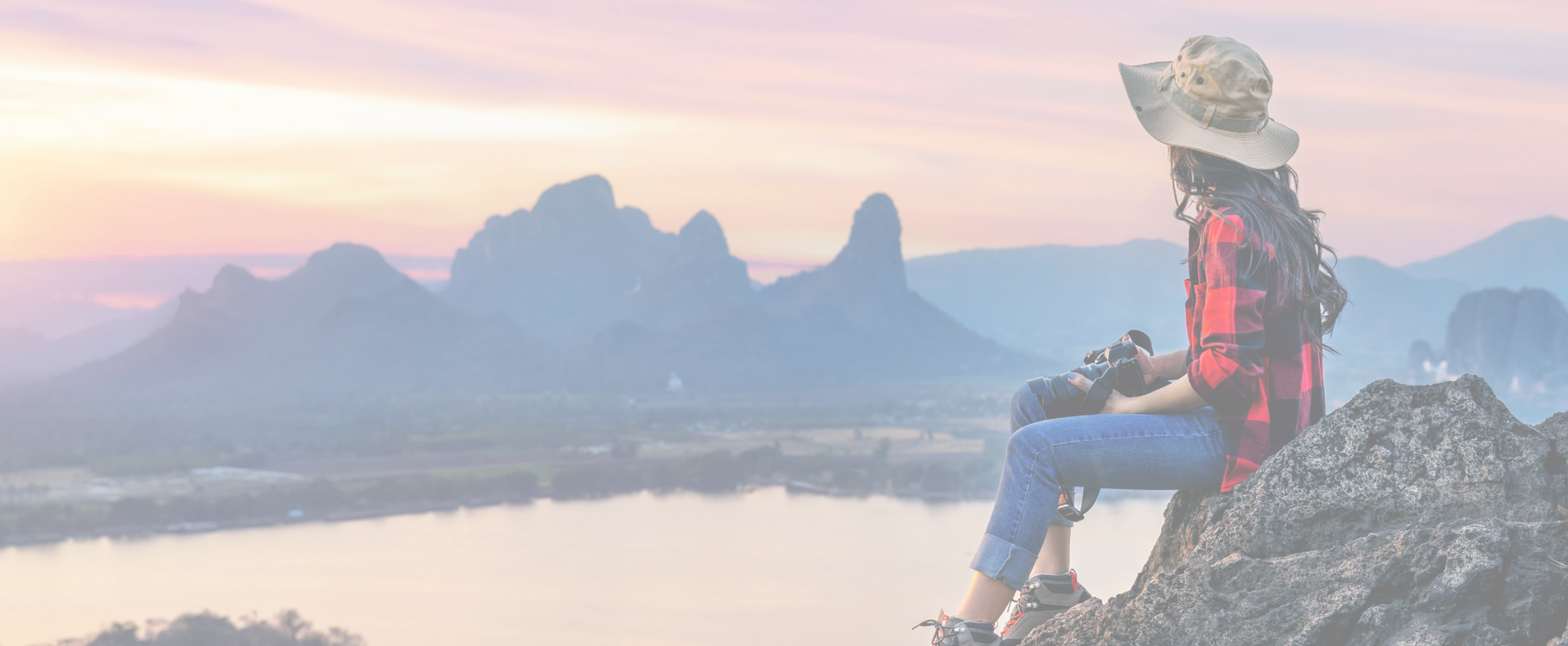
Newsletter
Sign up now!
Be the first one to know all about the Exciting Offers, Travel Updates and more.
Contact Us
B-42, 2nd Floor, Tower- B,
The Corenthum, Block A, Sector 62, Noida, Uttar Pradesh 201301
© 2015-2024 JustWravel Pvt. Ltd.
Starts From
₹ 9,500


.webp)




